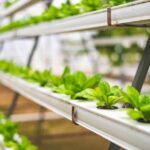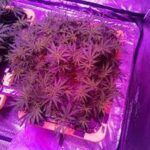What Is Vertical Hydroponics?
Vertical hydroponics is a type of hydroponic gardening where plants are grown in vertically stacked layers, often in a tall cabinet or similar structure. This method of growing can be very efficient since it takes up less space than traditional horizontal hydroponic setups.
Additionally, vertical hydroponics systems can be easier to maintain and provide better airflow to the roots of the plants, which can lead to healthier growth.
What are the 5 types of hydroponic systems?
Table of Contents
The five most common types of hydroponic systems are:
1. Wick Systems
2. Ebb and Flow (Flood and Drain) Systems
3. Deep Water Culture (DWC) Systems
4. Nutrient Film Technique (NFT) Systems
5. Aeroponic Systems
Each system has its own set of benefits and drawbacks, so it’s important to choose the one that will work best for your needs.
Wick systems are the simplest type of hydroponic system, and they are often used by beginner gardeners. A wick system consists of a container of nutrient-rich solution (the “reservoir”), and a growing medium (such as coco coir or perlite) that is saturated with the solution. The plants are placed in the growing medium, and their roots come into contact with the nutrient solution through the wicks.
What is the easiest hydroponic system to use?
Ebb and flow (flood and drain) systems are one of the most popular types of hydroponic systems. They are relatively easy to set up and use, and they can be adapted to a wide range of plant types.
Ebb and flow systems work by flooding the root zone of the plants with nutrient solution for some time (usually about 15 minutes) and then draining the solution back into the reservoir. This cycle is repeated several times throughout the day.
What is the best type of hydroponic system?
There is no single “best” type of hydroponic system, as each has its advantages and disadvantages. The best system for you will depend on your specific needs and goals.
If you are just starting, a wick system may be the best option, as it is simple to set up and use. If you want to grow a large number of plants, or if you have limited space, a vertical hydroponic system may be the best option. And if you are looking for maximum efficiency and yield, an aeroponic system may be the best choice.
What are the disadvantages of hydroponics?
There are a few potential disadvantages to hydroponic gardening, including:
1. Higher initial cost: Hydroponic systems can be more expensive than traditional soil-based setups.
2. Requires more attention: Hydroponic systems require more regular maintenance than soil-based gardens.
3. Can be difficult to troubleshoot: If something goes wrong with a hydroponic system, it can be difficult to figure out the cause of the problem.
Overall, however, the advantages of hydroponics far outweigh the disadvantages. Hydroponic gardening is a great way to grow healthy plants without the use of soil, and it can be an extremely efficient and space-saving method of gardening.
Which type of hydroponics is best?
There is no single “best” type of hydroponics, as each has its advantages and disadvantages. The best system for you will depend on your specific needs and goals.
If you are just starting, a wick system may be the best option, as it is simple to set up and use. If you want to grow a large number of plants, or if you have limited space, a vertical hydroponic system may be the best option. And if you are looking for maximum efficiency and yield, an aeroponic system may be the best choice.
How do you set up a vertical hydroponic system?
Vertical hydroponic systems can be set up in several different ways, but the most common method is to use a series of PVC pipes arranged in a vertical column. The pipes are filled with a growing medium, and the plants are placed in the pipes.
A nutrient solution is then pumped through the system, watering the plants and providing them with the nutrients they need to grow.
What is the most efficient hydroponic system?
The most efficient hydroponic system is the one that best meets your specific needs and goals. If you are looking for maximum efficiency and yield, an aeroponic system may be the best choice.
If you have limited space, a vertical hydroponic system may be the best option. And if you are just starting a wick system may be the best option, as it is simple to set up and use.
Can you grow rice on a vertical farm?
Yes, you can grow rice on a vertical farm. Vertical farming is a type of agriculture that utilizes vertically stacked layers to grow crops in a controlled environment. Vertical farms can be used to grow a wide variety of crops, including rice.











